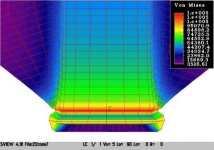Joe Friedrich
Member
O'kay don't tease me with one word answers. Joe, have you heard about anybody starting to play with one of Gene's deals? Half of my curiosity stems from the fact that several guns now that are based on the the actions requiring a larger tenon involve a machined bushing to allow a straight, smaller diameter barrel and no step down. Moving to essentially a 2-step bushing that allows for rotational ability with no longitudinal change seems like it could be a worthy experiment. I'm guessing that it would require the larger actions in this application to avoid too small a tenon, but that's just a guess.
Tim no, I have not heard of anyone using Gene's system at this time but will assume there will be some that will give it a go. Gene's system is brilliant and it would make it easy once the bushing is installed for someone to index their own barrel using their own platform and yes it would require the larger action at this time.
Joe


